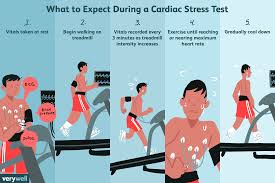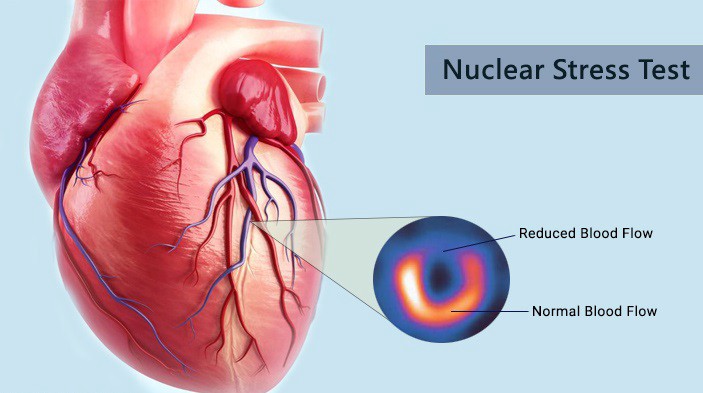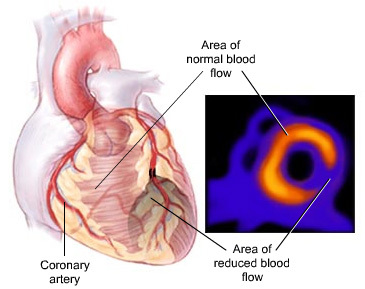



A stress test, sometimes called a treadmill test or exercise test, helps your doctor find out how well your heart handles its workload. As your body works harder during the test, it requires more fuel and your heart has to pump more blood. The test can show if there’s a lack of blood supply through the arteries that go to the heart.
Taking a stress test also helps your doctor know the kind and level of physical activity that’s right for you.
The two main types of stress testing are a standard exercise stress test and an imaging stress test.
A standard exercise stress test uses an EKG (electrocardiogram) to detect and record the heart's electrical activity.
An EKG shows how fast your heart is beating and the heart's rhythm (steady or irregular). It also records the strength and timing of electrical signals as they pass through your heart.
During a standard stress test, your blood pressure will be checked. You also may be asked to breathe into a special tube during the test. This allows your doctor to see how well you're breathing and measure the gases that you breathe out.
A standard stress test shows changes in your heart's electrical activity. It also can show whether your heart is getting enough blood during exercise.

As part of some stress tests, pictures are taken of your heart while you exercise and while you’re at rest. These imaging stress tests can show how well blood is flowing in your heart and how well your heart pumps blood when it beats.
One type of imaging stress test involves echocardiography (echo). This test uses sound waves to create a moving picture of your heart. An exercise stress echo can show how well your heart's chambers and valves are working when your heart is under stress.
A stress echo also can show areas of poor blood flow to your heart, dead heart muscle tissue, and areas of the heart muscle wall that aren't contracting well. These areas may have been damaged during a heart attack, or they may not be getting enough blood.

Other imaging stress tests use radioactive dye to create pictures of blood flow to your heart. The dye is injected into your bloodstream before the pictures are taken. The pictures show how much of the dye has reached various parts of your heart during exercise and while you're at rest.
Tests that use radioactive dye include a thallium or sestamibi stress test and a positron emission tomography (PET) stress test. The amount of radiation in the dye is considered safe for you and those around you. However, if you're pregnant, you shouldn't have this test because of risks it might pose to your unborn child.
Imaging stress tests tend to detect CHD better than standard (nonimaging) stress tests. Imaging stress tests also can predict the risk of a future heart attack or premature death.
An imaging stress test might be done first (as opposed to a standard exercise stress test) if you:

You may need stress testing if you've had chest pains, shortness of breath, or other symptoms of limited blood flow to your heart.
Imaging stress tests, especially, can show whether you have coronary heart disease (CHD) or a heart valve problem. (Heart valves are like doors; they open and shut to let blood flow between the heart's chambers and into the heart's arteries. So, like CHD, faulty heart valves can limit the amount of blood reaching your heart.)
If you've been diagnosed with CHD or recently had a heart attack, a stress test can show whether you can handle an exercise program. If you've had percutaneous coronary intervention, also known as coronary angioplasty, (with or without stent placement) or coronary artery bypass grafting, a stress test can show how well the treatment relieves your CHD symptoms.
You also may need a stress test if, during exercise, you feel faint, have a rapid heartbeat or a fluttering feeling in your chest, or have other symptoms of an arrhythmia (an irregular heartbeat).
If you don't have chest pain when you exercise but still get short of breath, your doctor may recommend a stress test. The test can help show whether a heart problem, rather than a lung problem or being out of shape, is causing your breathing problems.
For such testing, you breathe into a special tube. This allows a technician to measure the gases you breathe out. Breathing into the tube during stress testing also is done before a heart transplant to help assess whether you're a candidate for the surgery.
Stress testing shouldn’t be used as a routine screening test for CHD. Usually, you have to have symptoms of CHD before a doctor will recommend stress testing.
However, your doctor may want to use a stress test to screen for CHD if you have diabetes. This disease increases your risk of CHD. Currently, though, no evidence shows that having a stress test will improve your outcome if you have diabetes.
Doctors use exercise stress tests to find out: